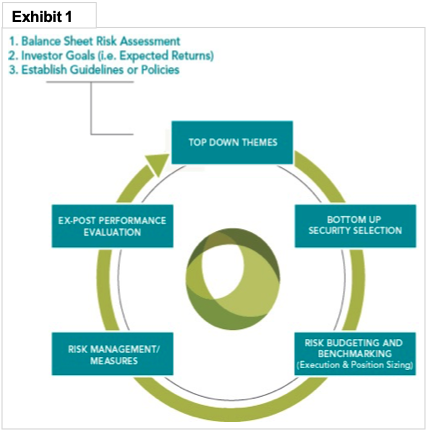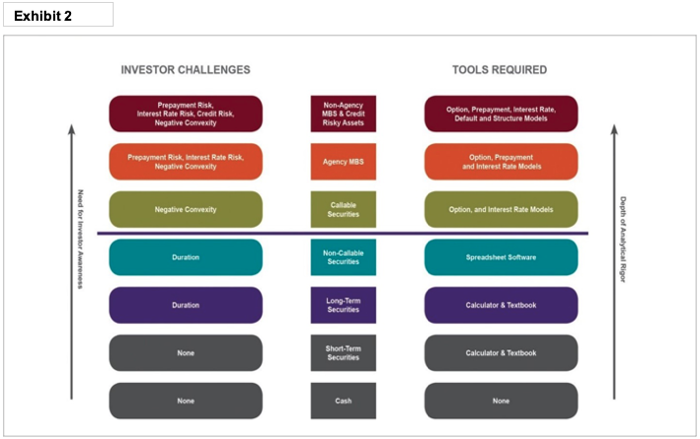Fundamental investing principles for depository institutions

There are many types of investors in the institutional fixed income world: hedge funds, mutual funds, depositories, insurance, corporations, pensions, and endowments, to name several. Many of these investors are differentiated by the assets they manage, but unique to depositories is their liability mix. A depository’s liability mix acts as an organic interest rate hedge for both the assets in the investment portfolio and full balance sheet, and it is a significant competitive advantage for depository investors.
In the current environment, there are many opportunities in the fixed income universe given the significant increase in both yields and yield spreads. In such a volatile interest-rate environment, a thorough investment process becomes even more critical in evaluating such opportunities.
A Process that Remains Constant
Although the interest rate outlook may change, your investment process should remain constant. A well-thought-out investment philosophy and disciplined investment strategy can assist your depository in creating a portfolio that remains sound – in any rate environment. By creating a sound strategy and framework, investment decisions become independent of interest rate levels. That’s why we advise all of our financial institution clients to focus on process, rather than simply considering individual investment options in the context of the latest outlook for rates.
The investment portfolio serves an important role within a depository’s overall balance sheet management process. Regardless of the portfolio’s specific objective (liquidity, income, etc.), the ultimate goal should be to maximize return per unit of risk taken.
Investment managers may make hundreds of fairly routine decisions over the years. That’s why it is so important for a depository to have a well-defined investment process and decision-making framework to help ensure the portfolio generates reasonable risk-adjusted returns. Institutional fixed-income portfolio management is best thought of as a “rinse and repeat” process, in which portfolio riskiness is increased when compensation for risk is high and vice-versa.
For example, if yield spreads and expected returns on corporate bonds or mortgage-backed securities (MBS) are low, portfolio weights and exposure to these assets would also be low. As spreads widen relative to U.S. Treasuries or interest-rate swap rates, exposure is increased.
A successful fixed-income manager should be armed with both rigorous trading-level analytical models and a data- and research-oriented framework to address portfolio management in a controlled manner. Individual security selection can be thought of as the raw materials for portfolio returns. As a best practice, managers should also consider relative value analysis using robust trading-level analysis in an option and credit-adjusted framework.

Exhibit 1 displays a portfolio management process that begins with an assessment of the overall balance-sheet risk profile. In particular, the securities portfolio should be managed within an asset liability management framework, which accounts for the balance sheet’s existing relationship between the asset and liability risk profiles. Arguably most important is interest-rate risk; managing the duration of the portfolio such that the duration of equity is either mitigated or targeted appropriately is very important. However, other considerations, such as liquidity risk, credit risk and earnings needs, also come into play. Depository investors don’t manage their investment portfolios in a vacuum, and the portfolio duration target should be developed in such a framework. Once portfolio objectives are established, it’s important to ensure the guidelines/policy allow for successful implementation of the strategy. If they aren’t aligned, the depository’s portfolio manager is limited in his/her ability to deliver long-term performance goals.
From here, top-down market themes lead the way through the investment process. Top-down themes communicate the current assessment of various market metrics and risk factors, which drive sector allocation decisions. Security selection, risk budgeting, and risk measurement bring us to the finish, with ex-post performance evaluation.
Actively managed fixed-income portfolios are at some stage of this feedback loop at all times. For example, we might see monthly top-down themes, combined with daily security selection, weekly risk analysis and monthly performance reporting. Duration-targeting and interest-rate risk management take the guesswork off the table.
NOTE: There’s no discussion here on the direction of rates or when the Fed is going to move. Interest-rate forecasts, rate bets, and trades that are explicitly positioned for a specific interest-rate change have no place in this process and often can cause portfolio managers to rue the day. Instead, portfolio performance comes from good, old-fashioned risk measurement and management, as well as sector and security selection.
Why Depositories Need Analytical Models
It’s vital for financial institutions to have analytical models to identify and measure risks and potential returns. In today’s dynamic fixed-income markets, the need for robust models increases with the complexity of the assets or asset classes being evaluated.

Exhibit 2 shows this graphically. The line in the sand is clearly drawn between option and credit embedded assets and their other, simpler, cousins.
MBS are better evaluated using Monte-Carlo simulations given the path-dependent nature of the prepayment option, while it’s best to evaluate callable bonds using a lattice approach. Interest-rate and option models should price market instruments accurately and be arbitrage free, and prepayment models should exhibit a “best data fit” approach. Without these tools, investors are unable to properly evaluate market pricing of such assets.
Don’t forget the popular phrases “model users beware” and “use models at own risk.” There are plenty of historical examples of financial models leading investors to their early demise. Models are only as good as the assumptions that go into them, requiring an investment in the human capital needed to properly manage robust analytical systems. So, proceed cautiously; understand the inputs and assumptions; and absolutely, positively be critical of outputs. That’s why feedback loops are such an important component of the overall investment process. Models can help us make decisions, but they are not the end-all, be-all.
Third-Party Considerations
Brokers provide a necessary service, but in the end, they simply offer the ingredients to a recipe that has already been developed. Don’t make investment decisions solely based on what you are being shown by brokers; rely on your investment process and decision-making framework.
A growing number of depositories are turning to experienced external advisors, both for expert guidance and to outsource specialized functions like investment and balance-sheet advisory. An institutional asset manager can provide the tools and resources (both systems and human capital) needed to build and maintain high-performing bond portfolios at a fraction of what it may cost to attain those resources internally.
When seeking outside counsel on investing, financial depositories must understand how that advisor is compensated (e.g., fee-based or commission), and performance must be measured relative to the stated portfolio objectives. That said, a thoughtful and disciplined investment process should lead to more consistent and predictable earnings from the fixed-income portfolio.
Ready to learn more? Visit www.almfirst.com to sign-up for our daily insights via email or to contact us to discuss your institution’s investment needs.





